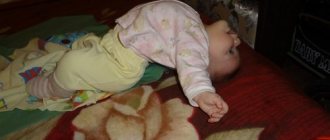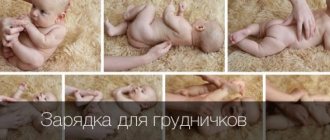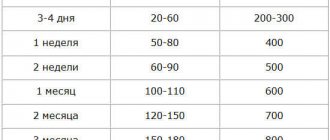Hypertonicity is a violation of the muscle tone of the body, which is expressed in muscle overstrain. Almost all babies are born with severe muscle hypertonicity. After all, while inside the womb, the baby is constantly in the fetal position. The limbs and chin in this position are pressed closely to the body and the muscles of the fetus are constantly tense.
hypertension in children under one year old
Until about six months, the baby’s nervous system “learns” to work in conditions different from those in the womb. The baby gradually develops and slowly begins to control the movements of his muscles and skeleton. In a one-month-old baby, hypertonicity is very pronounced. This is reflected in clenched fists and bent legs, and in throwing the head back. The tone of the extensor muscles in a one-month-old baby is higher than the flexor muscles.
With physiological hypertonicity, the child’s legs move apart only 450 degrees each. When moving your legs away, you feel a pronounced resistance to movement. By three months, muscle hypertonicity in a child without pathologies practically disappears. If muscle tension persists after your child reaches six months, you should immediately consult a doctor.
Symptoms of hypertension
Complications during pregnancy, birth injuries, Rh conflict, incompatibility of the blood of parents, residence in a poor environmental situation and many other factors will cause hypertension. It is worth paying close attention to the symptoms of hypertonicity, because this can be an expression of a serious neurological disease.
Signs of severe hypertension:
Restless and short sleep. In the lying position, the head is thrown back, and the arms and legs are tucked. When trying to separate the baby's legs or arms, strong resistance is felt. The child cries at the same time. Secondary dilution increases muscle resistance. Vertically on a hard surface, the child tries to stand on the front part of the foot, that is, stands on tiptoes (Information: if the child walks on tiptoes). When crying, the child throws his head back, arches, and at the same time his chin muscles tremble (See the article on chin tremor). Frequent regurgitation. Painful reaction to various stimuli: light, sound. From birth, the baby “holds” his head due to constant tension in the neck muscles.
It is important to determine as early as possible that a child has hypertension. Finding at least one of the above symptoms in your baby is a good reason to contact a pediatric neurologist. The diagnosis of “hypertonicity” will be made if the flexion tone is higher than expected at a given age.
Muscle hypertonicity is determined by several reflex tests:
Sitting by the hands: it is impossible to take the baby's hands away from the breast. Step reflex. When in an upright position, the child seems to be trying to take a step. Lasts after two months. Support reflex: a standing child leans on his toes. Preservation of asymmetric and symmetric reflexes after three months. When the child tilts his head to his chest while lying on his back, his arms bend and his legs straighten. When turning the head to the left in the same position, the left arm is extended forward, the left leg is extended, and the right leg is bent. When you tilt to the right, everything is repeated in a mirror image. Preservation of the tonic reflex after three months: lying on his back, the child straightens his limbs, and bends them on his stomach.
If by a certain age these reflexes do not weaken and do not disappear later, it means that the child has severe muscle hypertonicity. Therefore, it is necessary to consult a doctor.
More about newborn reflexes
Consequences and danger
Why is hypertonicity so dangerous if its occurrence is caused by the position of the fetus itself? Physiological hypertonicity disappears without a trace after three months. Pathological hypertonicity is caused by damage to brain tissue, which is responsible for the condition of the muscles. Such disorders occur with increased intracranial pressure, perinatal encephalopathy, increased excitability and other pathologies.
muscle hypertonicity
If, after three months, hypertonicity in children persists, the consequences, in the absence of treatment, are disastrous. Lack of regulation of muscle tone will affect the further development of the child:
Impaired coordination of movements; Formation of abnormal gait; Incorrect formation of posture; Developmental delays, especially motor skills; Speech impairment.
Hypertonicity of the legs
It is especially dangerous if the child develops severe hypertonicity in the legs. It affects the rate of development of motor activity. Babies with this diagnosis later begin to crawl and walk. For children with hypertonic legs, the use of walkers and jumpers is especially contraindicated. These devices increase the state of tension in the muscles of the legs and spine due to the uneven distribution of gravity. The load increases specifically on the muscles of the pelvis and spine.
Hypertonicity of the arms
Hypertonicity of the arms is expressed in muscle resistance when moving the arms away from the chest and tightly clenched fists. This condition is most often observed with physiological hypertonicity. However, prolonged persistence of muscle tension should concern the child’s parents.
See video:
How to determine hypertension in an infant
Hypertonicity in a child is not always determined only after 6 months; this can be done immediately after birth. Its main features:
- Nervousness of the baby, restless sleep, prolonged crying for no reason.
- Throwback of the head, both during sleep and while awake.
- Trembling of the chin when crying.
- The baby's arms and legs are very tightly clenched, and with any attempts to straighten them, the child resists and cries.
- When you try to put him on his feet, he must stomp by inertia. If he steps on his toes, then this is also a sign of illness. Normally, children step on their entire foot, just like an adult when walking.
Treatment
Correct and timely treatment of hypertension is carried out exclusively by a specialist doctor - a pediatric neurologist. All procedures are prescribed only by the attending physician. The sooner you start treatment, the better and faster the positive results will appear.
There are several techniques and directions in medicine that allow you to relieve hypertension:
Relaxing massage. Physiotherapy. Electrophoresis. Paraffin applications (heat therapy). Swimming. Drug treatment.
As can be seen from the list, to remove hypertension, medications are used last. These are drugs that relax muscles, reduce muscle tone and diuretics to reduce brain fluid levels. In addition to the massage, dibazole and B vitamins may be prescribed.
Massage
Massage for hypertonicity can be done independently at home starting from two weeks of age. Naturally, you first need to consult with a specialist in children's massage and get instructions and recommendations for massage from him. A total of ten sessions are carried out, which are best repeated again after six months.
The massage consists of three types of influence techniques: stroking, rubbing and rocking:
With the back of your hand we stroke the surface of your arms, legs and back. You can alternate superficial stroking with your fingers with grasping stroking with the whole brush. Circular rubbing of the skin. The baby is placed on his tummy and rubbed in a circular motion with his fingers using stroke movements from bottom to top. Then the same is done with the limbs, turning the child onto his back. Take the baby's hand and shake it slightly. In this case, you should definitely hold your hand in the forearm area. Carry out the procedure with both arms and legs. Take the baby by the arms above the wrist and rhythmically swing his arms in different directions. Grab the child's legs by the shins and rock them. Finish the massage by gently stroking your arms and legs.
If you have hypertonicity, you should not use deep muscle kneading, patting or chopping techniques. All movements should be smooth and relaxing, but rhythmic.
Video: how to massage for hypertonicity
https://youtu.be/Ax4dsUa-ZGw
Baths
An excellent remedy for relieving hypertension are herbal baths. Water itself has a relaxing property, and in combination with herbs it becomes an excellent remedy for hypertension. Take turns for four days to take warm baths with valerian root, lingonberry leaf, motherwort and sage. A break is taken for one day, the procedures are repeated again, and so on for 10 days. Pine baths also have an excellent relaxing effect.
Torticollis in newborns: treatment Infant arches his back and cries
A newborn baby spends only a small part of the day awake, so let him spend this time in activity. To swaddle a child or not, whether this will help to quickly remove hypertension in a newborn - let's figure it out together.
Physiological muscle tone
The movements made by a newborn baby are erratic. He still can't hold his head upright well. The baby tries to maintain the “embryo” position:
arms and legs are bent at the joints and pressed tightly to the chest, fingers clenched into fists.
Until the age of three months, this situation is called physiological hypertonicity. If after this age the tone of the flexor muscles in the arms and legs does not disappear, this is considered a deviation from the norm and requires correction.
The speed of transition from random movements to more conscious ones depends on the level of muscle development. But the main thing is how quickly the sensory and motor parts of the brain are formed.
Newborns, from the moment of birth, have a number of skin reflexes, when irritated, certain movements occur. While the baby still has physiological hypertonicity of the flexor muscles, it is necessary to provoke those responses that will promote extension. This principle underlies all movement exercises.
To balance the tone of different muscle groups, daily exercises with the newborn are necessary:
stimulating the “revival complex” with affectionate conversation; provide the opportunity to actively move independently, eliminating tight swaddling; daily warm baths; proper carrying of the child in your arms; gymnastic exercises and light stroking massage of the whole body;
Children's general relaxing massage
In order to bring the baby's muscle tone back to normal and help the natural development of the entire musculoskeletal system, you should do a relaxing massage daily.
First, we massage the child’s feet, stroking and moving from the heel to the toes.
We move on to stroking the baby’s legs; from the shin we rise to the thigh, massage the thigh with smooth circular movements of the fingers. We massage the baby’s second leg in the same way.
The next stage is a shoulder and chest massage. With light stroking movements we massage the shoulders, then the chest, lower ourselves onto the left hand, massage it. Then the right one.
After we have relaxed the arm muscles, we massage the stomach: we stroke it with light pressure, moving clockwise around the navel.
Then we do a light acupressure facial massage. Using your fingertips, knead the skin on your face from the middle of your forehead to the corners of your lips.
Symptoms of hypertension
Parents should be wary if, after three months, the child continues to clench his hands tightly into fists and bend his limbs. Pathological hypertonicity can manifest itself in different ways in newborns, the symptoms depend on the degree of tension of different muscle groups. Secondary manifestations of violations are:
sensitive and restless sleep; newborn chin tremor; frequent and profuse regurgitation; decreased appetite; holds his head from birth (spasm of the neck muscles), read more about when a child begins to hold his head>>>; excessive stiffness of movements; the newborn cries for no reason and for a long time.
To determine muscle hypertonicity in infants, place the child on a flat surface:
if the foot fits tightly to the support, there is no reason to worry; if the baby stands on tiptoes, this indicates increased tone. Read about other reasons in the article: The child walks on his toes, reasons?>>>
IMPORTANT! A pediatrician and neurologist should diagnose and treat hypertension. If you have corresponding symptoms, you should consult a doctor and tell your observations.
Summing up
The first year of a baby’s life is perhaps the most alarming for mothers. But don’t be tense or scared if a neurologist and therapist have diagnosed you with “hypertonicity.” Act calmly, confidently and clearly, find a neurologist in whom you are confident , follow all the doctors’ instructions.
Massage, baths, gentle tactile contact, breastfeeding, fresh air, aromatherapy, a lot of love and patience - and your diagnosis will forever remain in the past.
Why you can’t leave muscle hypertonicity in a baby unattended, what the dangers of this condition are and how to bring the tone back to normal, learn from the video.
Treatment
If hypertension in infants does not go away on its own, treatment is prescribed by a neurologist to avoid the following negative consequences:
The increased tone of a child’s legs affects the slowdown in the development of motor activity, so babies later begin to crawl and walk. Subsequently, this may manifest itself as coordination disorders, incorrect posture, and clubfoot. Read more about when does a child begin to crawl?>>> The formation and improvement of fine movements of the fingers will be disrupted. Possible speech impairment and developmental delay. The factor that provokes hypertonicity is circulatory disorders. In adulthood, this will manifest itself as headaches, even migraines.
It is best to carry out complex treatment:
massage; gymnastics; relaxing baths; electrophoresis; affectionate communication; paraffin therapy.
In case of metabolic disorders in the brain, specialists prescribe medications. These are gentle drugs with a diuretic effect to improve cerebral circulation.
It is necessary to treat
There is no need to heed the advice of “those who know and are experienced” that “everything will pass on its own, it will grow out” and that “everyone is like this, and there is nothing special.”
Hypertonicity must be removed - otherwise your child will later straighten his fingers, learn to take objects and manipulate them, if hypertonicity is in the muscles of the hands; later he will stand on his feet and learn to walk if his legs are in spasms. As a result, he will noticeably lag behind in development, suffer from a lack of coordination, posture, and possible clubfoot.
In addition, hypertonicity has a very dangerous companion - a violation of the blood circulation of some parts of the brain , which, being untreated since childhood, will subsequently begin to remind itself of itself with constant and painful headaches.
Therefore, be sure to undergo all the examinations prescribed for you, which will probably include neurosonography - an ultrasound examination of the baby’s brain through the “fontanelle” that has not yet closed. It will allow specialists to identify possible pathologies and prescribe adequate treatment, which is most effective before the age of one.
Massage and gymnastics
A massage with increased tone can make the child feel relaxed and comfortable. Gentle tactile contact has a variety of beneficial effects on the body.
During manipulation, nerve impulses are transmitted to the cerebral cortex, exerting a tonic effect on the central nervous system, increasing control over the functioning of all body systems.
The techniques have different effects on the central nervous system: stroking, gentle rubbing and kneading enhance inhibitory processes. They are used to reduce hypertension in a child and relax muscles.
IMPORTANT! YOU can perform massage and gymnastics complexes yourself for the normal growth and development of the child.
Dr. Komarovsky believes that there is no need to contact professional massage therapists if an appropriate neuropathological diagnosis has not been made.
Conditions for conducting exercises
The massage can be performed on any hard surface, but a changing table is best.
The selected place is covered with a straightened flannelette blanket, with oilcloth and a clean diaper on top. The table should be positioned so that it is possible to approach the baby from any side. In Europe, experts recommend working with your child on the floor.
The room should have good lighting, away from heating devices and drafts. If the room is well ventilated, the effect of the massage will be combined with hardening the body. In the warm season, exercises are carried out with an open window or in the fresh air. You should not start exercising immediately after feeding; you must wait 40-45 minutes. You must be prepared. Watches, rings and other jewelry must be removed during the procedure. Clothes should be loose and not restrict movement.
IMPORTANT! The massage is performed with clean hands. Oils and creams add slippage, and the correct technique for performing techniques is disrupted. Talc and other powders are not used because they dry out the baby's skin. If your hands are dry and can injure the baby’s delicate skin, then before performing a massage, you should soften them a little with special oil. If your palms are wet, you can use baby talc.
In the cold season, it is worth covering the child with a warm diaper, exposing only the area of the body being massaged.
Set of techniques
With hypertonicity, it is necessary to balance muscle tone in infants; massage is used to achieve this goal. During classes, it is necessary to carefully observe the child’s reaction. At the first signs of discomfort in the baby, it is worth changing or ending the set of exercises.
You should start the massage slowly and calmly, gradually lengthening the time and intensity of the massage.
Sample lesson plan:
Hand massage. Place the child on his back with his feet facing the parent. Place your thumb in your newborn's hand, holding your right hand with your left hand and your left hand with your right. Stroke with the same hand from the hand to the armpit 6-8 times. Raising the body from the position: lying on your back. The baby's hands clasp the mother's thumbs. Raise your baby's upper body a few centimeters. You should perform 7-8 approaches in a minute. Foot massage. The exercise is performed in the same way as when stroking the hands. Back massage. A newborn baby is placed on his stomach, with his arms extended forward. Without pressure, the mother's hands slide from the bottom to the top of the child's back with the dorsum, and in the opposite direction with the palm. Repeat 6-7 times. Foot massage. The child's leg is held by the shin. The index and middle fingers of the other hand fix the foot, and the thumb “draws” a figure eight. The sole of the other foot is massaged in the same way. Shaking hands. The hand of a newborn baby is taken in the same way as when stroking. Shake both hands very lightly, spreading them slightly to the sides. Swinging on a ball. The child is placed face down on a regular inflatable ball or fitball, knees spread apart. The baby should be held by the back. Gently swing the ball in different directions for about two minutes.
Exercises should be started from the age of two weeks, gradually increasing the time of classes. You can use other sets of exercises for hypertension in infants. Videos prepared by professional massage therapists will be a good assistant for mastering new skills.
How to massage a newborn, watch the video:
Execution technique
Massage for infants with hypertonicity includes movements that can be divided into 2 groups:
- techniques that affect all muscle groups;
- techniques that affect specific muscles.
It is not recommended to perform movements from the second group at home. It should be done by a specialist. But general relaxation can be done for all kids. The “cradle” technique gives a very good relaxing effect. Even the smallest children are allowed to do it. The child is rocked, held under the head and back. You can place the baby on his stomach, holding him by the chest.
If the child is already holding his head confidently, you can use the “swing” technique. To do this, you need to take the crumb of the armpit and lift it, swinging it slightly. Movements should be slow and smooth. They will help the baby relax and tune in to the right mood.
Legs
Leg massage for hypertonicity is performed in a horizontal position. The heels should “look” at the massage therapist. During the procedure, each leg is massaged separately. It is lifted by the foot with the opposite hand and held with the middle and index fingers. The other one performs the massage itself. You should not straighten the limb completely, as this may cause discomfort to the baby. The leg should be slightly bent.
Massage for muscle hypertonicity in a 3-month-old child includes the following movements:
- Stroking. It is recommended to start the procedure with these movements. They allow you to warm up your muscles and prepare them for the upcoming massage. Stroking should be done from the lower leg, moving gradually upward to the side and then to the front of the thigh. Stroking should be careful, without effort, so as not to cause pain to the child. Repeat 7-10 times.
- Rubbing. Performed with fingertips. With increased tone, infants are recommended to make straight and spiral movements. Rubbing should begin from the shin, slowly moving towards the thigh. It is enough to repeat 2-3 times.
- Pressure. To relax the muscles of the legs, you can also perform pressing movements. They are also performed with the pads of the fingers from the shins towards the hips. The pressure should be light, and massage should not cause pain to the child.
- Piston rubbing. A relaxing massage for infants with hypertonicity also includes piston rubbing. They are performed as follows: they clasp the child’s leg with their palms and begin to rub it, as if warming it up. The movements are performed first in one direction, then in the other. It is enough to repeat 2-3 times in each direction. You need to move from your shins towards your hips.
- Squeezing movements. They do it like this: the child’s leg is placed between two palms and they begin to press lightly on it, as if squeezing it. But here you need to be careful - you don’t need to squeeze the limb too much. This may cause discomfort for the child. You also need to move from the shin to the reed. 2-3 repetitions are enough.
Foot and sole
After the basic movements have been completed, you can begin massaging the feet and soles. To do this, use the following techniques:
- Rubbing. Use the pads of your finger to massage your foot. For this purpose, you can use circular, straight and spiral movements. The intensity of pressure should gradually increase during the process, but not cause discomfort to the baby.
- Drawing a figure eight. A good movement that affects almost all points of the feet. It is enough to draw a figure eight 5-6 times. With each subsequent movement, the pressure should increase.
- Rubbing fingers. Each finger is massaged separately. In this case, circular movements of medium intensity are used.
- Stroking. This is the finishing movement. It is performed from the heel towards the toe. Here the intensity of the pressure gradually decreases.
Performing such a massage is recommended not only for those children who have been identified with increased tone, but also for those who do not have it. After all, it has a beneficial effect on the overall well-being of the baby and helps him get closer to his family.
During the massage, the baby should also be in a lying position. Massaging the hand, the masseur places the finger of the left hand into the child’s palm, and with the right one grabs the wrist joint and moves it towards the shoulder.
It is recommended to do such procedures every day. And after 10-14 days, you can add rubbing of the limbs to these techniques.
Gymnastic movements
Massage for hypertonicity of the arms and legs also includes gymnastic movements. They also provide muscle relaxation and improved extensor functions. There are several movements that can be used at home.
- Extension and flexion of the legs. Each leg is massaged separately. It is necessary to grasp the limb in the heel area with one hand and straighten it with the other so that the hip and knee joint are involved in the process. While performing the movement, it is necessary to observe the child’s reaction. If the technique causes discomfort, it is better to abandon it or perform it with less intensity.
- Reduction of the legs. The massage therapist's hands should be placed on the baby's lap. The knees should be brought together and lightly pressed towards the tummy. There is no need to apply strong pressure.
- Leg spreads. First you need to spread your knees in different directions, and then connect them and lightly press them to your stomach. When the limbs are pressed to the stomach, you need to smoothly rub your feet against each other.
Children's massage for hypertension has many benefits. In addition to the fact that it helps restore muscle tone, it also improves the mental development of infants and normalizes sleep. And if you supplement the procedure with various songs and poems, this will also have a positive effect on the development of speech.
According to Dr. Komarovsky, increased hypertonicity can be compared to a suitcase that was forgotten on the train. Nobody knows what is inside it. Maybe there is nothing scary in it, or maybe there is a bomb in it. And to prevent it from exploding, you should definitely check this suitcase. So it is with infants. If you suspect increased muscle tone, it is better to show your baby to a specialist once again, rather than sit and wonder what it is and why.
And massage itself for muscle hypertonicity in a child is only an auxiliary therapy. If the newborn does have any health problems, they need to be treated. And until they are eliminated, no massage will help. They will only help slow down the progression of the disease.
Relaxing baths
It is best to bathe your newborn in a small bathtub using grandma's old-fashioned method (also called diaper bathing). Such bathing relaxes the child, reduces stress levels and has a relaxing effect on the body. Read more about caring for a newborn and gentle bathing >>>
IMPORTANT! You shouldn't teach a baby to dive. Diving under water is stressful for the baby; this will increase muscle tone and negatively affect the child’s emotional state.
If a child has hypertonicity of the leg muscles, it is recommended to add decoctions of chamomile, string, motherwort, valerian, lavender or oregano to the bath. All natural ingredients can cause an allergic reaction, so you should start bathing with the addition of one type of medicinal herb.
Sweet talk
The basis of good health is the good cheerful mood of the newborn. Any emotion has a special impact on the nature of the cardiovascular system. Sadness, fear or anger can cause vasoconstriction and disruption of tissue trophism. Joy - creates favorable conditions for the functioning of the body.
Gentle touches and the mother's quiet and sweet voice calm and relax the child. They cause a smile and a feeling of delight in the newborn, which creates favorable conditions for full development.
Increased muscle tone in a baby - how dangerous is it?
Nine out of ten newborns are diagnosed by pediatricians with “muscle hypertonicity.” What is this - pathology or normal? And how dangerous is this for the future development of the baby? Let's try to figure it out together.
What is tone? The mechanism of muscle tone
Tone (from the Greek τόνος - tension) is a state of persistent excitation of muscle tissue and nerve centers. Thanks to it, we maintain a certain posture, body position in space, pressure in the cavity of the internal organs (perhaps during pregnancy, you came across the concept of “hypertonic uterus,” that is, overly tense).
Natural muscle tension is maintained by impulses coming from our central nervous system, even at rest.
And if during pregnancy, increased tension in the muscle fibers of the uterus is dangerous for the baby in it, then its own hypertonicity is absolutely physiological . All the muscles of the unborn child are contracted for greater compactness, the arms, legs and chin are pressed to the body. This is the classic “fetal position.”
Hypertonicity of muscles in newborns
Almost all babies are born with physiologically increased muscle tone. This is due to the fact that the newborn has not yet had time to adapt to an “autonomous existence.”
The tone in the child’s neck extensor muscles is higher, so his head is slightly tilted back. In the adductor muscles of the hips, their increased tension resists the attempt to separate the legs of a newborn baby. Normally, they can be moved apart by 90 degrees - 45 degrees in each direction.
What should you be wary of in a baby’s behavior?
The reason to consult a neurologist should be the absence of a decrease in tone
Source
Preparation for the procedure
To do this, you just need to carefully observe the child for some time and perform simple manipulations.
Perhaps the main signs indicating hypertonicity are restless behavior and nervousness ; when the baby cries, the chin trembles. Symptoms of increased muscle tone also include:
- Periodic intense regurgitation.
- Restless and short-term sleep, the child wakes up with the slightest noise.
- The characteristic positions that children take when sleeping are their heads thrown back, legs and arms connected. If you try to separate the limbs, with hypertonicity the baby will resist and may wake up and cry .
- The child throws his head back and arches his whole body when he cries.
You can carefully take the baby under the arms, lower his legs to the floor and tilt his torso slightly.
A child who feels well will place his entire foot on the floor, but with muscle hypertonicity he will touch the floor with his toe.
Similar reactions occur in completely healthy children, and only a pediatric neurologist can definitively diagnose hypertonicity.
Experts point to several possible causes of muscle tension: hemolytic disease of the baby, incompatibility of blood groups or Rh factors, malfunctions in the baby’s nervous system.
Pathologies of the nervous system, in turn, can be caused by:
- Chronic intoxication of a woman during pregnancy due to illness.
- Constant tension in the muscles of the uterus during pregnancy.
- In cases where pregnancy occurred simultaneously with treatment of acute infectious diseases.
- Threatened miscarriage, difficult pregnancy.
- Labor that is too long or too fast.
- Intense toxicosis in the first or last stages of pregnancy.
- Poisoning of the fetus as a result of smoking and drinking alcohol by a pregnant woman.
- Hypoxia of the child’s brain during childbirth or pregnancy.
- Chronic diseases of the mother.
- Improper execution of the incision during caesarean section.
Muscle tone in infants
Increased muscle tone in infants and newborns
With the advent of the first-born child, a lot of questions arise in every modern family. And the most important question is the health of the baby (is he healthy or not), will he walk, run, jump, and what is the condition of his muscles. And what is muscle tone in a baby and why is it dangerous in general? And with these questions, young parents often come to a pediatrician for a consultation. The simple concept of “muscle tone” is the natural state of the muscles, which maintains the position of the entire body and plays a large role in the process of movement. Muscle tone, both in adults and in infants, must be physiologically correct.
The child, while still in the womb, makes its own unique movements. He does this chaotically, reflexively, with muscle contraction. When a baby is born, muscle tone helps its overall development. The most obvious muscle tone includes the baby holding his head and turning it in different directions. Later he learns to sit upright: sit, crawl, walk, jump, run, dance... And a certain muscle tone is responsible for all this. Depending on the child’s action, the muscles can be in strong medium and minimal tension. In the state of sleep, the muscles completely relax.
You can observe the following interesting situation with a child (with healthy development): if the baby, at first glance, is in a supine, relaxed state, then his muscles, one by one or in pairs, simultaneously experience tension. This tension allows you to hold the entire body or individual parts of the body. All muscles are not tensed equally. It depends on the level of completion of the task that the child needs to do.
Children, in the first months of their unconscious life, have higher muscle tone than older children. All this is due to the fact that, being in the womb, as an embryo, the unborn child grows and develops every day, and m
Source
The effect of massage on muscle tissue
In the human body there are about 600 muscles, which consist of fibers through which they are connected to each other by an intercellular substance. Muscles are striated and smooth. The former line the surface of the body under the skin; they are the ones who are subject to increased stress in newborns. Massage for a 3-month-old child with hypertonicity has a beneficial effect on the muscles:
- Increases the elasticity of muscle fibers.
- Redox processes are accelerated.
- Eliminates muscle starvation.
- Muscle metabolism and tissue nutrition are normalized.
- Helps relax baby's muscles.
- Reduces lactic acid levels in muscles.
After the first 3-4 sessions with a specialist, the child’s condition will improve significantly. The baby will begin to sleep better, and regurgitation will decrease. The baby’s body movements will become smooth and relaxed.
Parents and doctors should cooperate in the treatment of the child. Doctors instruct mothers to do gymnastic exercises at home, visit the pool, and do a smoothing massage for the baby on their own.
Therapeutic massage has its own characteristics. Only a specialist doctor who works with children can carry it out correctly. The main movements are smoothing, since the child’s body is very fragile, and the skin is easily subject to injury.
Massage to relieve muscle tone in a 3-month-old baby is prescribed 2-3 times a week. The specialist shows parents how to properly exercise at home with their newborn. The course lasts 15-17 sessions with a break of 3 weeks, until the age of 1 year.
Collage: a child gets a massage
Muscle tone in a newborn: what you need to know?
The baby makes the first movements with the help of the muscle-joint sense. It also gives the baby an incentive to develop. When parents hear the term “muscle tone” from a pediatric neurologist, it very much puzzles them, since it is not clear whether such a condition threatens the baby’s health.
What is muscle tone?
Human movements are impossible without the so-called muscular-articular sense. It is thanks to him that the baby can make movements immediately after birth. Thanks to muscle tone, the baby understands his position in space and begins to develop physically and mentally: he begins to hold his head up and rolls over. Thus, tone is the minimum muscle tension that is inherent in skeletal muscles that are at complete rest.
In the first months of life, babies are characterized by slightly increased muscle tension. This phenomenon is due to the fact that when the fetus was in the mother’s womb, it did not have enough space for active movement. At the same time, all his muscles were in a tense state. Despite the fact that a baby is born with hypertonicity, muscle tension in different groups is uneven. This explains why children press their legs and arms to themselves.
Increased muscle tension begins to gradually decrease as the child approaches 3-4 months of age. By 5-6 months, the tone is uniform for all muscle groups.
Causes
Muscle tension disorders are associated with the functioning of the central nervous system in humans. Thus, any changes in pathological tone signal a disease. The causes of such muscle disorders are illnesses that the mother suffered during pregnancy:
Such complications lead to damage to the baby’s brain due to insufficient oxygen supply to his tissues.
Source
Website about the health, development and education of preschool children
Increased muscle tone in a child
The concept of muscle tone in medicine is minimal muscle tension, remaining in a calm and relaxed state. Under external influences, muscles can tense or relax. One of these manifestations is often increased muscle tone in a child, resulting from any abnormalities. This increase in medical terminology is called hypertonicity.
Child's tone
All children have increased tone at birth. This physiological manifestation is associated with a long stay of the fetus in the mother’s womb. All this time, the chin and limbs were pressed tightly to the body. This condition of the unborn child was accompanied by severe muscle tension.
In the first months after birth, you need to especially carefully monitor the state of muscle tone. During this period, all deviations are most clearly manifested. If timely measures are not taken, the child’s gait and posture may be impaired in the future, and motor development may begin to lag. Therefore, parents should constantly observe and record all his movements and postures, without waiting for a visit to the pediatrician. The indicator of muscle tone in newborns is not only the basis for any movements. It accurately reflects the general condition of the baby, including his nervous system.
Muscle hypertonicity
Increased tone in children is additionally defined as hypertonicity. In this state, the child often cries, shows anxiety, and sleeps poorly. He is irritated by any sounds or too bright light. Due to the tension of the neck muscles, the baby's head is held well from birth. He constantly presses his arms and legs, trying to bring them together. When trying to separate the limbs in different directions, a noticeable resistance is felt
Source
Muscle hypertonicity in children under one year of age: symptoms, consequences and treatment, massage for hypertonicity
Hypertonicity is a violation of the muscle tone of the body, which is expressed in muscle overstrain. Almost all babies are born with severe muscle hypertonicity. After all, while inside the womb, the baby is constantly in the fetal position. The limbs and chin in this position are pressed closely to the body and the muscles of the fetus are constantly tense.
Until about six months, the baby’s nervous system “learns” to work in conditions different from those in the womb. The baby gradually develops and slowly begins to control the movements of his muscles and skeleton. In a one-month-old baby, hypertonicity is very pronounced. This is reflected in clenched fists and bent legs, and in throwing the head back. The tone of the extensor muscles in a one-month-old baby is higher than the flexor muscles.
each. When moving your legs away, you feel a pronounced resistance to movement. By three months, muscle hypertonicity in a child without pathologies practically disappears. If muscle tension persists after your child reaches six months, you should immediately consult a doctor.
Symptoms of hypertension
Complications during pregnancy, birth injuries, Rh conflict, incompatibility of the blood of parents, residence in a poor environmental situation and many other factors will cause hypertension. It is worth paying close attention to the symptoms of hypertonicity, because this can be an expression of a serious neurological disease.
When trying to separate the baby's legs or arms, strong resistance is felt. The child cries at the same time. Secondary dilution increases muscle resistance.
baby size chart
The birth of a baby makes every mother rack her brain over choosing clothes for him. Set the size, quality, color, comfort - in a word, so that the suit fits. But it is not the selection process itself that is difficult, but the
Vertically on a hard surface, the child tries to stand on the front part of the foot, that is, stands on tiptoes (Information: if the child walks on tiptoes).
Source
Causes
hypertonicity, newborn, massage for a newborn, gymnastics for a newborn, treatment of hypertonicity Why does this happen? There are two reasons. The first is perinatal encephalopathy - dysfunction of the central nervous system caused by exposure to negative factors on the baby (from the prenatal period to the first days of life). They may be:
- diseases of the mother of a somatic nature, in which chronic intoxication occurs;
- acute infectious diseases of women during pregnancy (toxoplasmosis, herpes, chlamydia), intrauterine infections;
- metabolic disorders and the presence of genetic diseases;
- pregnancy with a pathological course, when there is early and late toxicosis, threat of miscarriage, fetal hypoxia, etc.;
- bad habits of the mother (alcohol, smoking), which cause disruption of blood flow in the uterus, alcohol and nicotine poisoning of the fetus;
- the presence (in women) of chronic diseases of the heart, kidneys, liver, disorders of the endocrine system;
- pathological course of labor, that is, when rapid labor occurs or, conversely, there is weak labor activity, a long anhydrous period, poor opening of the birth canal, obstetric aid (vacuum extractor, “forceps”, etc.);
As a consequence of perinatal encephalopathy, three degrees of hypertonicity are distinguished: mild - manifests itself in the first two months of life, moderate - observed for more than two months, and severe - lasts a whole year. Another factor that causes this disease is hemolytic disease of the newborn, which means the incompatibility of the Rh factor of the child with the mother.
About the tone of infants.
The baby's first movements occur thanks to the muscle-joint sense, with the help of which the child determines its place in space long before birth. In the first year of life, muscle-joint sensation gives the child a powerful stimulus for development. It is thanks to him that the baby learns to make conscious movements (raise his head, reach for a toy, roll over, sit down, stand up, etc.). And the main characteristic of the muscular skeleton of newborns is tone.
First of all, you need to understand what muscle tone is and what is considered normal. Even in sleep, our muscles do not relax completely and remain tense. This minimum tension, which remains in a state of relaxation and rest, is called muscle tone. The younger the child, the higher the tone - this is due to the fact that at first the surrounding space is limited to the uterus, and the child does not need to perform purposeful actions. In the fetal position (with the limbs and chin tightly pressed to the body), the muscles of the fetus are under strong tension, otherwise the child simply would not fit in the uterus. After birth (during the first six to eight months), muscle tone gradually weakens. Ideally, the muscle tone of a two-year-old baby should be approximately the same as that of an adult. But almost all modern babies have problems with tone. Poor ecology, complications during pregnancy, stress and a number of other unfavorable factors provoke impaired tone in newborns. There are several common muscle tone disorders.
discharge kit for a newborn in Minsk
PRINCESS set of 10 items: - blanket; - duvet cover; - corner; — overalls (velor); - blouse; - hat; - diaper; - vest; - cap; — bow Fabric: velor, satin, jersey
Set Smeshinka of 5 items
The child seems tense and tense. Even in sleep, the baby does not relax: his legs are bent at the knees and pulled up to his stomach, his arms are crossed on his chest, and his fists are clenched (often in a “fig” shape). With hypertonicity, the child holds the blood well from birth
Source











